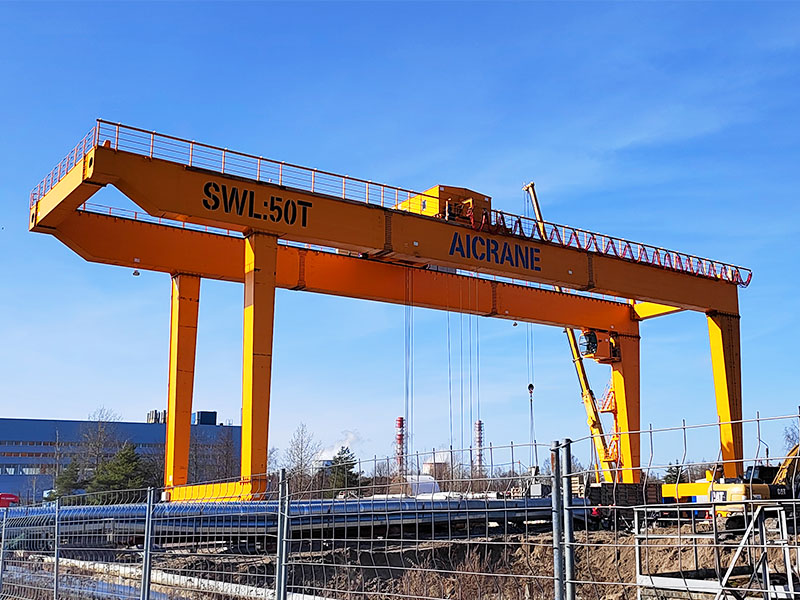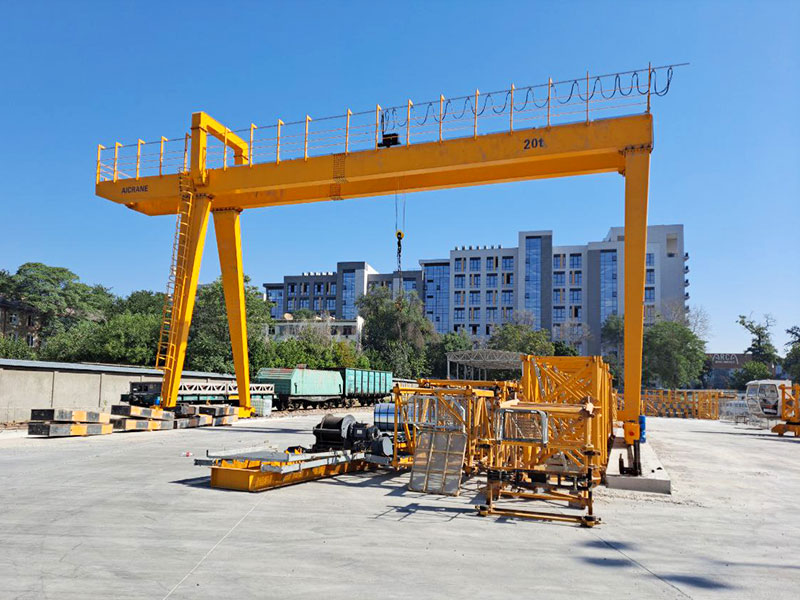Gantry cranes are indispensable lifting equipment across industries such as manufacturing, construction, shipyards, and logistics. One of the most critical factors influencing the structural design of a gantry crane is its lifting capacity. Whether a crane is designed to handle 10 tons or 50 tons, the lifting capacity dictates every aspect of the structure – from the girder and legs to the rail foundations and drive mechanisms.
This article explores the effect of lifting capacity on gantry crane structural design, using four common examples: 10-ton, 20-ton, 30-ton, and 50 ton gantry cranes.

Importance of Lifting Capacity in Structural Design
The lifting capacity of a gantry crane is not simply a measure of how much weight it can carry. It represents the total structural and mechanical capability of the crane to handle loads safely and efficiently. As the lifting capacity increases, several design aspects must be adjusted:
-
Girder design – Heavier loads require stronger girders, often shifting from an I-beam to a box girder design.
-
Support legs – The vertical legs must be reinforced to handle higher compressive forces.
-
Rail and wheels – Larger capacities increase the wheel load, requiring heavier rails and stronger foundations.
-
Hoist and trolley mechanisms – Motors, brakes, and gearboxes must be scaled to ensure safety and reliability.
-
Safety margins – Higher capacities demand stricter compliance with international standards to minimize risk.
10-Ton Gantry Crane Structural Design
The 10 ton gantry crane is a light-duty to medium-duty crane widely used in warehouses, workshops, and small fabrication plants. Its structural design emphasizes mobility and cost-effectiveness.
-
Girder: Usually a single girder structure made from I-beams or light box girders.
-
Legs: Relatively slender, designed for compact spaces, often fabricated from rolled steel sections.
-
Rail System: Can run on light rail tracks or even adopt a trackless rubber-tyred structure for greater mobility.
-
Hoist: Electric hoists are typically sufficient, offering smooth lifting at moderate speeds.
Because of its lower load demands, a 10-ton crane balances strength and economy, making it suitable for frequent but relatively light lifting tasks.

20-Ton Gantry Crane Structural Design
Moving up to 20 tons, the structural requirements become more demanding. This capacity is often needed in manufacturing plants, small ports, and logistics yards.
-
Girder: Depending on span length and duty cycle, the crane may still use a single girder box structure, but double girders are increasingly common.
-
Legs: Stronger box-type welded legs replace slender steel sections to handle the additional load.
-
Rail System: Requires sturdier rails with reinforced foundations to resist wheel pressure.
-
Safety Features: Load limiters and anti-sway systems are often integrated to maintain stability during lifting.
At this level, structural stiffness becomes critical. Even a slight deflection in the girder can affect load handling precision, so design engineers must factor in stricter deflection limits.

30-Ton Gantry Crane Structural Design
The 30-ton gantry crane is widely used in construction projects, steel yards, and precast concrete plants, where heavy loads and long spans are common. Its structural design shifts towards heavy-duty construction.
-
Girder: Almost always a double girder gantry crane design to achieve higher strength and minimize deflection under heavy loads.
-
Legs: Fabricated box legs with thicker plates and reinforcements, often with bracing to enhance stability.
-
Rail System: Requires heavy-duty rails and strong foundations to distribute the significant wheel loads.
-
Trolley & Hoist: Larger hoists with robust motors, reducers, and braking systems ensure safe handling of heavy loads.
-
Safety Systems: Advanced anti-collision devices, wind-proofing mechanisms, and real-time load monitoring are often integrated.
At 30 tons, structural considerations also include dynamic loading factors, as heavy loads increase the stresses from acceleration, deceleration, and sway.
50-Ton Gantry Crane Structural Design
The 50-ton gantry crane represents a high-capacity heavy-duty crane for shipyards, large-scale construction, and heavy manufacturing industries. Its structural design is extremely robust, with safety and stability as top priorities.
-
Girder: Always a double girder box girder, often with a larger cross-sectional area and reinforced internal diaphragms to resist bending and torsional stresses.
-
Legs: Massive box-type legs, sometimes with lattice reinforcements depending on the application.
-
Rail & Foundations: Requires the heaviest rails, strong concrete foundations, and precise rail alignment to bear concentrated wheel loads.
-
Hoist & Trolley: Designed for synchronized operation, often with multiple hoists (e.g., 25+25 tons) to balance loads.
-
Structural Stability: Wind resistance, seismic resistance, and long-term fatigue life must all be carefully calculated.
At this capacity, gantry cranes are typically custom-engineered for specific applications, with FEM or FEA (Finite Element Analysis) simulations ensuring reliability under extreme conditions.
Comparative Analysis
| Capacity | Girder Type | Structural Legs | Rail/Foundation | Typical Use |
|---|---|---|---|---|
| 10 Ton | Single girder (I-beam/box) | Slender steel legs | Light rail / rubber tyres | Workshops, warehouses |
| 20 Ton | Single or double girder | Box-type welded legs | Medium rail | Logistics, manufacturing |
| 30 Ton | Double girder box | Heavy welded legs with reinforcements | Heavy-duty rail | Construction, steel yards |
| 50 Ton | Double girder reinforced box | Massive box/lattice legs | Heaviest rail & deep foundations | Shipyards, heavy industry |
This comparison shows how lifting capacity directly influences structural design, requiring progressively stronger materials, girder types, and support systems as the load increases.
Engineering Implications
-
Economy vs. Strength: Lower capacities prioritize cost savings and mobility, while higher capacities prioritize durability and stability.
-
Design Standards: As capacities increase, international standards like FEM, ISO, and CMAA impose stricter requirements.
-
Customization: Beyond 20 tons, most cranes require tailored designs to match operational and environmental conditions.
-
Safety: With higher capacities, the margin for error shrinks, making structural redundancy and safety systems essential.
Conclusion
The lifting capacity of a gantry crane for sale is the defining factor shaping its structural design. From a lightweight 10-ton crane with a single girder to a heavy-duty 50-ton crane with massive box girders and reinforced foundations, each step in capacity requires significant upgrades in materials, structural elements, and safety features.
For businesses, understanding this relationship ensures that the chosen crane is not only fit for purpose but also safe, reliable, and efficient in the long term. Whether in warehouses, construction, or shipyards, tailoring gantry crane structures to the required lifting capacity is key to successful and sustainable operations.